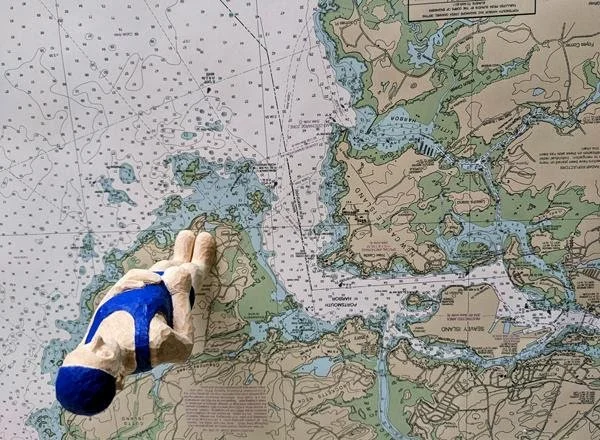
Coastal confrontation
From Boston-based artist Jessica Straus’s show “Stemming the Tide,’’ at the Brattleboro (Vt.) Museum, through Oct. 19
The museum says:
“A segmented map stretching across the gallery floor and rising to the ceiling is the central feature of Jessica Straus’s immersive installation. Its scale dwarfs us. The distinctive New England shoreline is recognizable. This is the Gulf of Maine, with waters descending from Ktqmkuk, now called Newfoundland, to Patuxet, the crook of land stretching out to the sea that we know as Cape Cod.
“Paired with the map is a series of photographs, partially occluded by hand-knotted fishing nets. In each image, a piece of the map floats atop lapping ocean waters, sometimes with the artist and other times adrift. The mesmerizing images allow us to contemplate the seen and unseen currents of the ocean.
“Deftly carved fish—cod—are scattered across the map. They are painted a ghostly white. In 1602, when Bartholomew Gosnold sailed into the southern terminus of the Gulf of Maine, its waters teemed with giant cod. That iconic fish is no longer abundant or giant.
“Woven together, the elements in “Stemming the Tide’’ provide a multifaceted and open-ended viewing experience.’’
'Poignant reminders'
From Jessica Straus’s show “Packing for Mars,’’ at Boston Sculptors Gallery, through May 5. She grew up on New Hampshire’s seacoast.
The gallery explains:
“Black humor, longing, and regret are all at play in ‘Packing for Mars’ . Straus looks forward with dread to a future when humans must flee a devastated Earth to settle on far flung, arid worlds. Yet, the artist is not packing gear for survival in a desolate landscape but, rather, offering poignant reminders of what has been left behind. Masterfully carved wooden figures stand-in for everyman and everywoman as they gaze longingly earthward from the moon, Mars and the star fields. Fragile hand-sewn earth spheres reveal vulnerability in their delicate stitching. In a particularly poignant series, Straus whittles plant specimens from her native New Hampshire, transforming them from humble grasses into botanical treasures. ‘Packing for Mars’ looks both backward and forward in time, as we each contemplate the preciousness of the environment we love and on which we all depend.’’
Hands across the seas
From “TransAtlantic,’’ a show by Jessica Straus at the Boston Sculptors Gallery, Dec. 12-Jan. 27.
The gallery explains:
“Jessica Straus's exhibition, ‘TransAtlantic,’ travels to Boston Sculptors Gallery after its 2017 premier in Athis de L'Orne, France. Originally commissioned as a site-specific installation for Le Temple Protestant, in a region of Normandy that suffered heavy bombardment during World War II, TransAtlantic commemorates the long and strong alliance between France and the United States. The installation is both political and personal. Straus's parents met as a result of her American father's participation as a soldier in the Normandy invasion and subsequent march into Paris, where he met the artist's mother, a French student.
‘‘For the installation at Boston Sculptors Gallery, the walls and floor will be clad in a room-sized World War II era map. A fleet of airplanes and an ocean liner criss-cross the Atlantic Ocean carrying correspondence between the artist's American and French families. Straus conceived of this work just as the current {Trump} administration was coming into power, reacting with alarm to the disturbing new era of xenophobia and nationalistic supremacy.
’’TransAtlantic serves as a reminder of the importance of alliances between nations and the possibilities that surface with openness to strangers.’’




